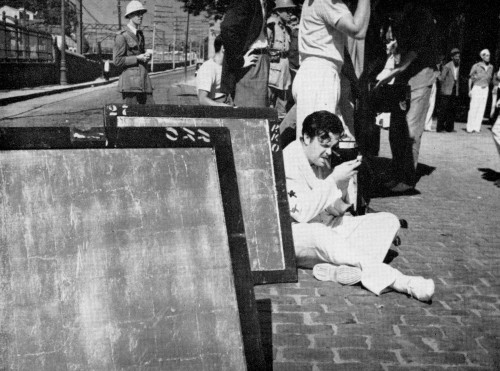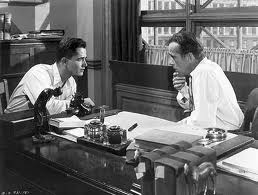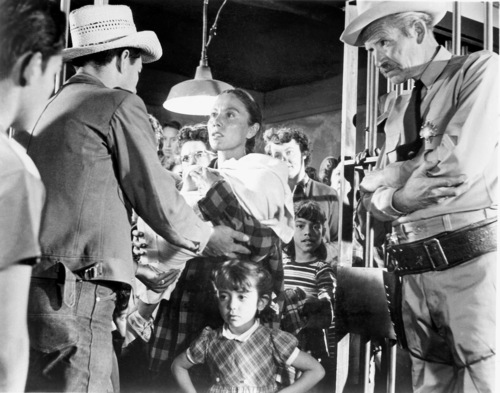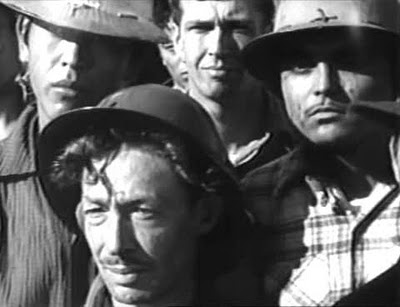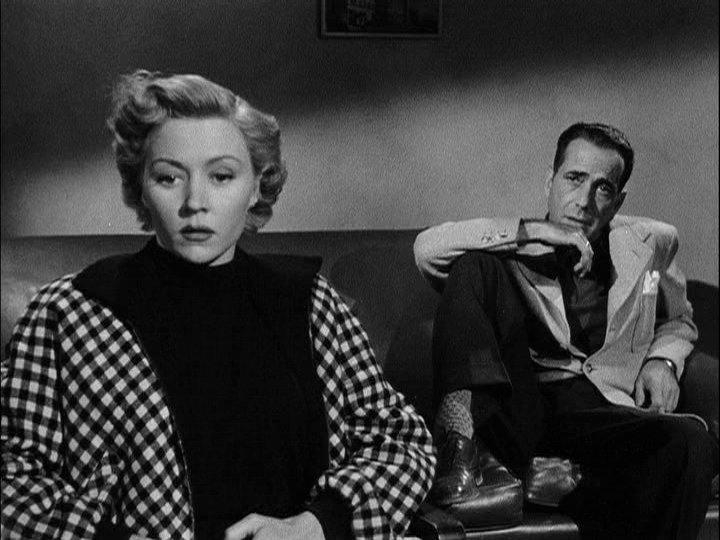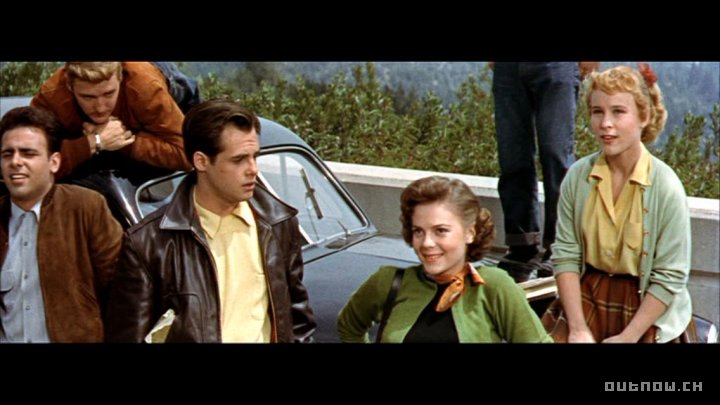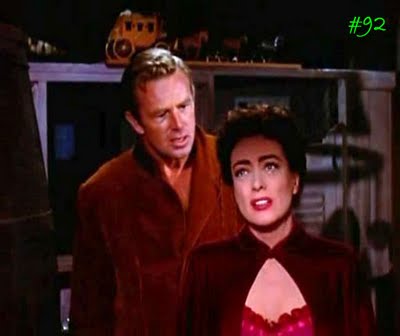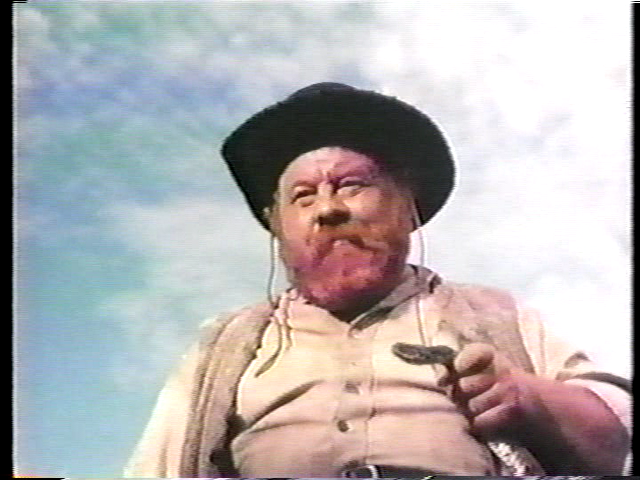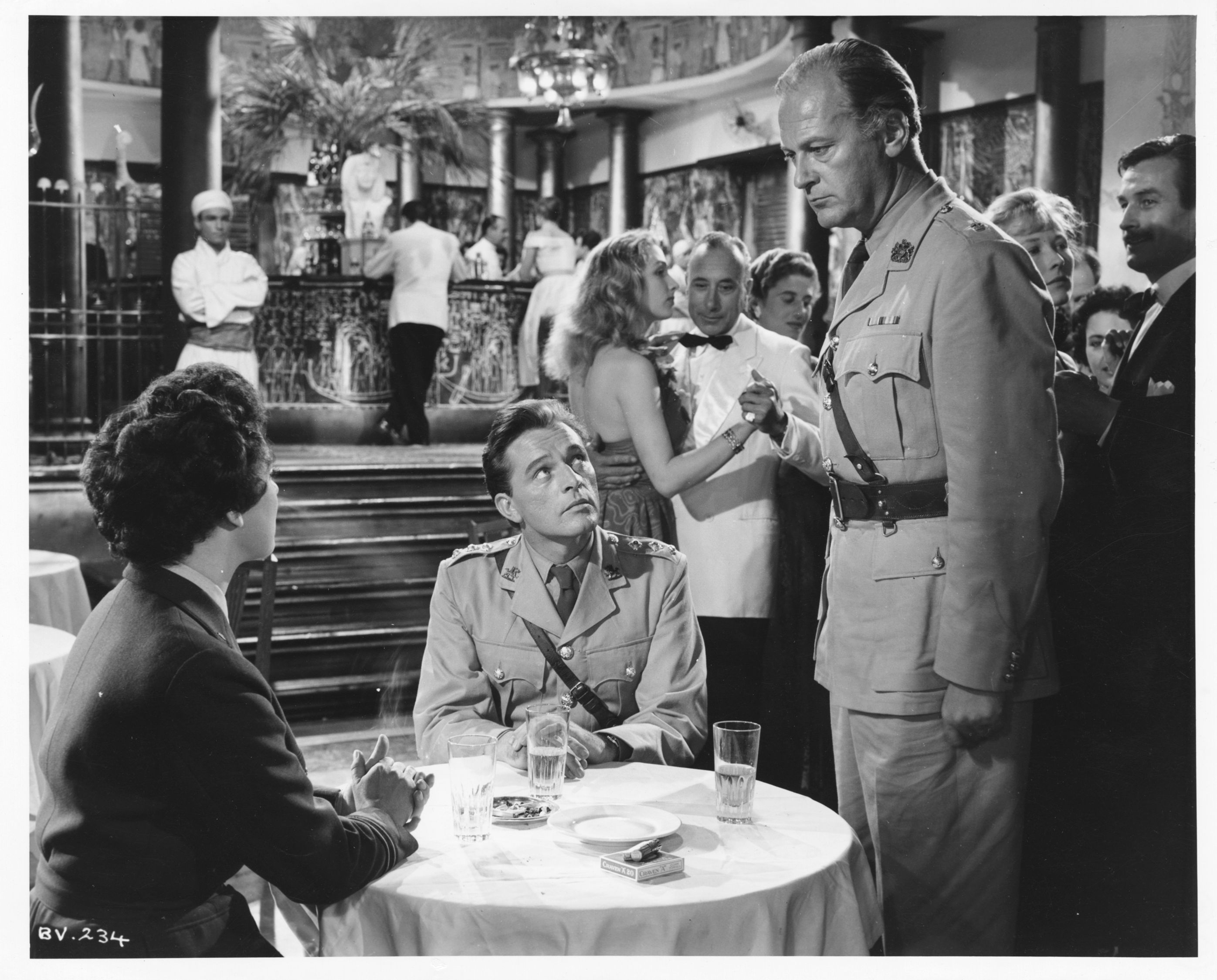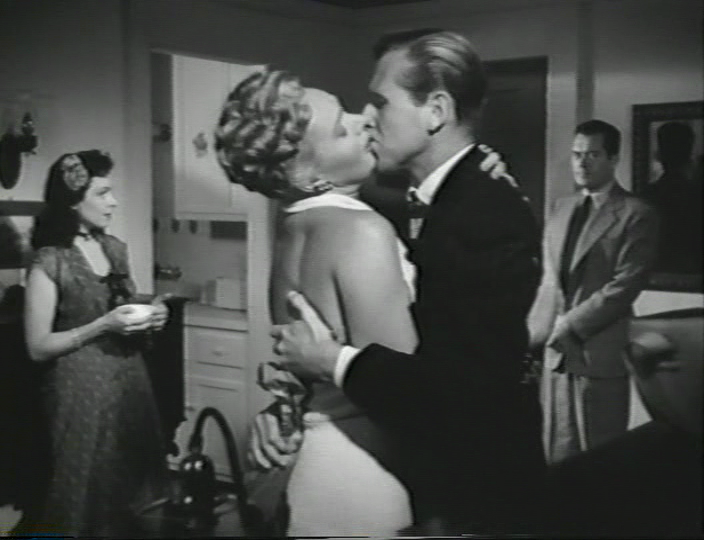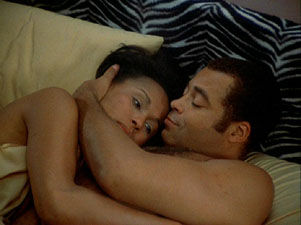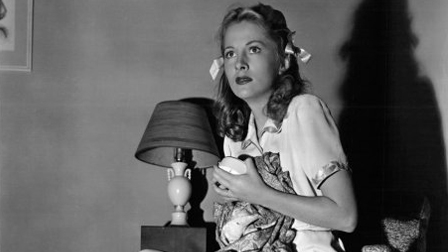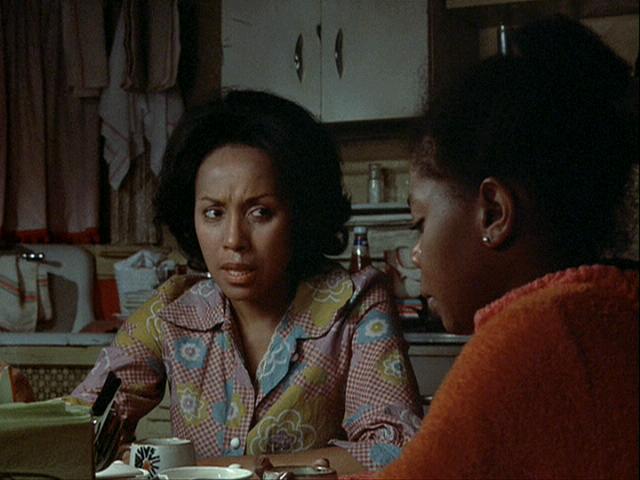From the September-October 1991 issue of Film Comment; this was also reprinted in my first collection, Placing Movies. — J.R.
If one were to undertake a diagnosis of the cultural and historical amnesia that currently afflicts American society in general and the American cinema in particular, the suppression of radical politics as part of our history might be a useful place to start. It is a suppression that comes in many forms, many of them barely conscious.
When a radical youth movie — PUMP UP THE VOLUME — actually gets made and released in the United States today, a repudiation of the 1960s counterculture becomes an obligatory part of its argument, because otherwise many contemporary teenagers would dismiss it out of hand. And when the same film gets reviewed in the United States, even most sympathetic critics find it convenient to overlook the fact that the film is political, for fear of alienating the public. Or when a recent film about Vietnam such as JACOB’S LADDER has the rare courage to attack the Pentagon (unlike, say, BORN ON THE FOURTH OF JULY and CASUALTIES OF WAR), one can predict that, given the present climate in America, it will be attacked by some critics for being exploitative and unserious — and praised by others as entertainment — whereas the issues broached by the film won’t be addressed at all.
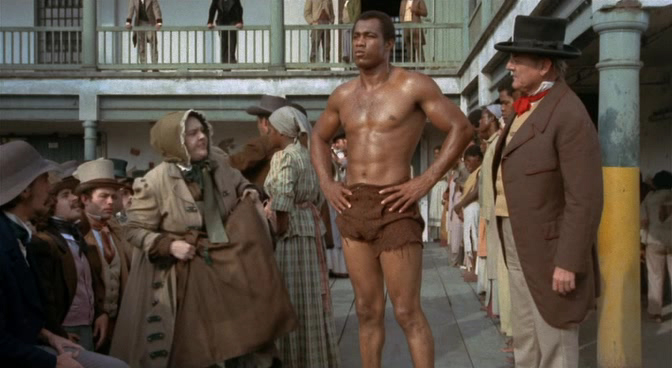
This is nothing new, I hasten to add. When films as antiracist as Cy Endfield’s ZULU (1964), Herbert Biberman’s SLAVES (1969), and Richard Fleischer’s MANDINGO (1975) were first released in the States, they were all generally either ignored in the press — as was Leo Popkin and Russell Rouse’s THE WELL back in 1951— or treated as if they were shameless pieces of racist exploitation. The diverse methods by which films of social protest become neutralized in mainstream discourse, through either misreadings or lack of attention, are too numerous and complex to be explored in detail here, but it is a problem that needs to be acknowledged at the outset. A related problem, to be sure, is the ideological cast of the period we’re living in — a period during which, for example, virtual celebrations of the FBI such as MISSISSIPPI BURNING and THE SILENCE OF THE LAMBS have been widely applauded as models of progressive thinking.
If a fear of the social movements of the 1960s has continued to characterize American life since the 1970s, it is equally true that a fear of the social movements of the 1930s was an important ingredient in American life in the 1940s and 1950s. We’re still living with the legacy of that fear, which in many cases has seriously warped our grasp of film history. It is difficult, for instance, to understand the full significance of CITIZEN KANE without a comprehensive understanding of Orson Welles’s links with leftist politics in his theater and radio work over most of the preceding decade. This is the subject of a forthcoming book by Michael Denning, but most accounts of KANE minimize this background. Few Welles scholars have shown much interest in, say, Welles’s original radio play His Honor the Mayor, which was broadcast less than a month before KANE ‘s release; it is a remarkable neo-Brechtian effort about racism, union-busting, and the right to free assembly that was widely (and quite implausibly) attacked in the Hearst press as communistic. And when it comes to understanding Welles’s subsequent work, the missing political context produces further distortions.
How many people today familiar with the story behind Welles’s unfinished IT’S ALL TRUE (1942), which had such disastrous consequences for the remainder of his career, are aware that the reasons why this film was never finished are largely political? Popular accounts usually assume that the project was aborted because Welles got “carried away” by the carnival in Rio, spent too much money, and behaved “irresponsibly.” But what scholars such as Robert Stam and Catherine Benamou have recently discovered and demonstrated in copious and persuasive detail* is that Welles’s “irresponsibility,” “profligacy,” “partying,” “self-indulgence,” and so on were little more than his determination to make a Hollywood movie about Brazil and Mexico that featured poor nonwhites in all the leading roles. So thoroughly has this central fact been papered over by studio propaganda and mythical hyperbole about Welles’s personality that even Welles’s most sympathetic biographers have failed to see the political dimensions of the project, or fully apprehend that Welles’s insistence on spending most of his time in Brazil with working-class blacks was what chiefly constituted his “carrying on” and “partying.”
***
How did such a situation come about? To trace a few of its many roots, one has to go back to the 1960s, when Andrew Sarris’s writings about auteurism were first appearing and influencing a whole generation of cinéphiles. Auteurism, as formulated by Sarris, was in part a reaction against socially conscious critics who valued films above all for their content and ignored their style. As Sarris wrote in his preface to The American Cinema , the bible of auteurism: “The sociologically oriented film historians — Jacobs, Grierson, Kracauer, Rotha, Griffith, Leyda, Sadoul, et al. — looked on the Hollywood canvas less as an art form than as a mass medium. Hollywood directors were regarded as artisans rather than as artists, and individual movies were less often aesthetically evaluated than topically synopsized.” There was enough partial truth in this charge to give Sarris’s “discoveries”—such directors as Hitchcock, Hawks, Samuel Fuller, and Nicholas Ray, whom he was controversially proposing as artists rather than as “mere” entertainers or studio hacks — the force of a revelation.
But it was a revelation that came at a certain price. “Thesis” cinema at its worst and least artistic was then represented by Stanley Kramer in the United States, André Cayatte in France, and the claims made by Sarris for Ray were strictly formal ones. Insofar as Ray’s films were socially conscious, they were inartistic by definition:
Nicholas Ray has been the cause célèbre of the auteur theory for such a long time that his critics, pro and con, have lost all sense of proportion about his career. Nicholas Ray is not the greatest director who ever lived; nor is he a Hollywood hack. The Truth lies somewhere in between. It must be remembered that THEY LIVE BY NIGHT, THE LUSTY MEN, REBEL WITHOUT A CAUSE , and BIGGER THAN LIFE are socially conscious films by any standards, and that KNOCK ON ANY DOOR is particularly bad social consciousness on the Krarner-Cayatte level. His form is not that impeccable, and his content has generally involved considerable social issues.
It is only when Sarris takes up Ray’s visual style, his principal “theme” (“that every relationship establishes its own moral code and that there is no such thing as abstract morality”), and his romanticism — all of which are felt to be divorced from his social meanings — that he can find the director’s work artistic.
Over a quarter-century since this was written, Sarris’s distinctions of this kind have become critical orthodoxy in the United States, although not in a manner that Sarris himself could have predicted. The immediate consequence of this position in relation to film history is a virtual effacement of certain films and creative individuals whose social orientations are too visible to be ignored or rationalized as something else. It is an unconscious form of censorship that can be found not only in The American Cinema and related works of critical reference such as Charles Flynn and Todd McCarthy’s Kings of the Bs, but even in more recent academic studies whose ostensible interests are social. Thus the names Cyril Endfield and John Berry — two important blacklisted directors I will be discussing later — are missing from Sarris and Flynn-McCarthy, as well as Peter Roffman and Jim Purdy’s The Hollywood Social Problem Film: Madness, Despair and Politics from the Depression to the Fifties (Indiana University Press, 1981) and, despite the notable contributions of both directors, most studies of film noir.
I don’t wish to imply that self-confessed auteurists and academies hold any sort of monopoly on obfuscating our radical past. Turn to “Morality Plays Right and Left,” the last essay in Pauline Kael’s first collection I Lost It at the Movies (1965), for an interesting hatchet job on SALT OF THE EARTH (1953) — the only overtly communist feature ever made in this country, and one of the few American films of the 1950s that qualifies as feminist. Kael links this independent effort — made in the teeth of enormous obstacles by a blacklisted producer (Paul Jarrico), screenwriter (Michael Wilson), and director (Herbert Biberman) — with the wholly forgettable anticommunist NIGHT PEOPLE , a routine Hollywood Cold War thriller of the same period; mutatis mutandis, it’s a bit like saying that Man’s Fate and Terry and the Pirates both boil down to the same nonsense. As Jarrico and others later described it, SALT OF THE EARTH was conceived as a “crime to fit the punishment”: since he, Biberman, and Wilson were already barred as subversives from work in the industry, they decided to make a subversive film outside the industry that would live up to their reputations.
This is not to suggest that SALT OF THE EARTH is above criticism, or that Kael doesn’t make some valid points about certain assumptions of socialrealist propaganda (although, for the record, this example of it holds up a lot better than NIGHT PEOPLE , even as entertainment). A closer look at her essay, however, reveals that she’s reviewing not the film itself but the published screenplay, which she quotes in copious detail. Perhaps she actually saw the film and is using the script as an aide de mémoire; if so, she doesn’t bother to mention that some of the material she quotes with such scorn doesn’t appear in the movie — a fact first pointed out to me by Jarrico himself. And since there’s next to nothing she has to say about the film that couldn’t be gleaned from the script and a few stills, it’s questionable whether her essay actually deals with the film at all. When we consider that the best-known review of SALT OF THE EARTH in this country is both unreliable as reporting and almost completely negative, it’s hardly surprising that few Americans today have much interest in seeing the movie (it’s much more widely screened in Europe); but it’s a film that cries out for revaluation.
Indeed, when we come to the era of the Hollywood Blacklist, we arrive at another kind of received wisdom: the observation that the writers, directors, and actors most persecuted by the House Un-American Activities Committee were chiefly untalented hacks whose politics were largely irrelevant, both to their martyrdom and to their work in film. But research carried out by Thom Andersen in the past several years suggests another story entirely — a story that needs to be told. Andersen’s lengthy, invaluable essay “Red Hollywood,” hidden away in a collection entitled Literature and the Visual Arts in Contemporary Society (Ohio State University Press, 1985), tells part of it; he and Noël Burch are planning a feature-length documentary on this subject that will undoubtedly tell still more.*
Another important piece of radical historiography is Bernard Eisenschitz’s massive biography, Roman américain: les vies de Nicholas Ray, published last year in France by Christian Bourgeois Éditeur and now being translated into English by Tom Milne (subsequently published as Nicholas Ray: An American Journey, Faber and Faber, 1993). The information and insights offered by both Andersen’s “Red Hollywood” and Eisenschitz’s biography formed the basis for “Nick Ray and/in America,” a special event at the Rotterdam Film Festival last winter (organized by Eisenschitz) that was an attempt both to recontextualize the films of Ray and to rediscover a tradition in both the American cinema and American history that four decades of amnesia and inadequate understanding have helped obscure. In broad terms, this project suggests the beginning of a revised social history we have only begun to uncover and recognize.
***
Nicholas Ray
I was born when she kissed me I died when she left me I lived a few weeks while she loved me
This brief poem, written and recited by screenwriter Dixon Steele (Humphrey Bogart) to Laurel Gray (Gloria Grahame) in Ray’s IN A LONELY PLACE , reflects not only the fleeting and fragile quality of both happiness and tenderness in much of Ray’s work, but also the highly limited and circumscribed way that Ray’s life and career are generally perceived by the world at large — when in fact they are perceived at all. Known to many chiefly as the man who directed James Dean in REBEL WITHOUT A CAUSE (1955), and to cinéphiles as a maverick director who imposed his romantic, lyrical, and semifatalistic view of the world on a series of disparate features made between the late 1940s and the early 1960s, Nicholas Ray is principally understood and appreciated today without much sense of a context beyond that of Hollywood.
This Hollywood context is complicated only slightly by a general recognition that Ray was the exemplary American director during the 1950s for many of the French critics writing for Cahiers du Cinéma and preparing to become directors themselves — above all, Jean-Luc Godard and François Truffant, but also to a certain extent Jacques Rivette and Eric Rohmer. It can even be argued that Ray’s work in the 1950s notably anticipates Godard’s in the 1960s in many of its most striking attributes: a strong sense of romantic fatalism, a passionate empathy for adolescents and other solitary existential heroes, a radical discontent with contemporary society, a particular flair for color and CinemaScope, a recurrent (but unfulfilled) desire to film a musical, and a taste for anarchic violence that complicates all of the above — culminating in grandiose fables, parables, and pedagogical “lessons” (THE SAVAGE INNOCENTS and KING OF KINGS, WEEKEND and LE GAI SAVOIR ), followed by a complete break with commercial filmmaking and the gradual forging of a new aesthetics based on greater degrees of collaboration and political commitment (WE CAN’T GO HOME AGAIN , Godard’s Dziga-Vertov Group films). Many of these parallels come together in Godard’s MADE IN U.S.A. , a film dedicated jointly to Ray and Samuel Fuller, whose uses of color, Scope, violence, lyricism, and a sense of political betrayal all point toward what Godard learned and applied from his mentors.
Another link between Ray and Godard — the prescient grasp of contemporary social issues before they became part of mainstream culture — suggests a context only incidentally that of Hollywood, pointing toward a wider grasp of cultural currents than are found in most branches of formal film criticism. Consider Ray’s handling of youth culture (REBEL), drugs (BIGGER THAN LIFE ), ecology (WIND ACROSS THE EVERGLADES), anthropology (THE SAVAGE INNOCENTS ), and even pop Christianity (KING OF KINGS suggesting a sort of JESUS CHRIST SUPERSTAR avant la lettre), all of which parallel Godard’s early interests in such matters as semiotics (ALPHAVILLE ) and Maoism (LA CHINOISE ). (By contrast, Godard’s own encounter with pop Christianity, JE VOUS SALUE MARIE , was not to take place until over two decades following KING OF KINGS.)
Despite the fact that Ray, born in 1911, was in his late thirties when his first feature was released (THEY LIVE BY NIGHT, 1949), and that he lived for almost another seventeen years after he collapsed during the shooting of his last commercial feature (55 DAYS AT PEKING , 1963), the fifty-odd years of his life not spent as a so-called professional filmmaker have counted for relatively little in most accounts of his work. Broadly speaking, to paraphrase Dix Steele’s poem, Ray “was born” when Dore Schary hired him in 1947; he “died” when Samuel Bronston abandoned him in 1963; and he “lived” for the sixteen years in between, during which he directed twenty features and portions of a few others.
***
The inestimable value of Eisenschitz’s biography is that it proposes another life (in fact, other lives, as the title expresses it) — not one that contradicts the first, but one that furnishes so much additional information that it refines and extends its meanings far beyond the limits of Ray’s years in the film industry. Three hundred and twenty-one pages of meticulous and enlightening details are accorded those sixteen years in this mammoth volume, but 230 additional pages devoted to “before” and “after” transform the meaning of that productive period, making it part of a much larger, infinitely richer history. And a substantial portion of what has been uncovered — excavated, one is tempted to say — is the buried history of the American radical left during most of this century.
During the 1930s and the early 1940s, for starters, Ray studied with Frank Lloyd Wright, became a member of the radical Theatre of Action, and did work for the Federal Theatre, Birkwood Labor College, the U.S. Government’s Resettlement Administration (which involved a great deal of travel across the country, organizing improvisational drama groups with rural workers, and extensive work with Alan Lomax in recording indigenous folk music that led to the discovery of Leadbelly, Woody Guthrie, Josh White, and Aunt Mollie Jackson, among others), and “Voice of America” radio programs.
Much of this activity has some bearing on THEY LIVE BY NIGHT , Ray’s first feature, based on a Depression novel by Edward Anderson called Thieves Like Us (which also served as the basis for Robert Altman’s film in the 1970s). Even before the movie’s credits appear, we see the two leading characters (Farley Granger and Cathy O’Donnell) kissing while a subtitle introduces them in consecutive phrases: “This boy . . . and this girl . . . were never properly introduced to the world we live in. . . . ” It’s as though Ray were parsing the lines of a folk ballad.
If Ray’s work as a whole seems founded on a feeling of disequilibrium continually striving for a sense of balance — a feeling especially evident in the poignant, precarious, and momentary symmetries formed by his romantic couples, but also found in the subjectively framed upside-down shots in REBEL WITHOUT A CAUSE, HOT BLOOD , and WIND ACROSS THE EVERGLADES —this instability is already present in the opening (postcredit) images of THEY LIVE BY NIGHT. The first helicopter shots in the history of cinema, they follow the path of a runaway car, and later careen past a bigger-than-life billboard (another important emblem of Ray’s cinema). As the plot develops, this disequilibrium is maintained through what might be called an erotic handling of domesticity which tums the continued efforts of “this boy and this girl” to settle down into a scrapbook of fleeting instants.
An image of home and security — represented by either a couple or a troubled, unachieved family — that is shattered into fragments is, of course, a key image of the Depression. It hovers over the remainder of Ray’s work like a malediction, without ever canceling out the utopian dreams of shared harmony that are equally a part of that period. Those dreams and their violent betrayals are likewise present in IN A LONELY PLACE, ON DANGEROUS GROUND , and THE LUSTY MEN — films whose very titles evoke the tortured worlds of their protagonists — and in JOHNNY GUITAR they form the core of the famous, embittered dialogue between Johnny (Sterling Hayden) and Vienna (Joan Crawford) about their past love (“Lie to me, tell me that all these years you’ve been waiting for me”).
The precise creative roles played by Ray in each of these films has in the past largely been a matter of conjecture; one of the most valuable accomplishments of Eisenschitz’s biography is to clarify as much as possible how much Ray brought to his scripts as well as his direction. In the case of this famous dialogue between Johnny and Vienna, Eisenschitz has discovered that a former relationship between these characters was not even indicated in the various versions of the script — making it highly likely that Ray contributed this crucial element (and this scene) himself.
It has been debated how much of the legacy of Ray’s radical background in the 1930s and 1940s can be seen in his films of the 1950s, but there is certainly no question that it is present. Even in a lesser effort, THE TRUE STORY OF JESSE JAMES , one finds an instant lesson in anarchist economics when James pays off the mortgage of a sweet old lady with stolen money, then steals the same money back from her landlord a moment later. Radical considerations of who actually constitute society’s outlaws can be found in WIND ACROSS THE EVERGLADES, THE SAVAGE INNOCENTS, and to some degree in the uneven but vibrant HOT BLOOD , Ray’s film about gypsy life (which is also the closest he ever came to making a musical). BIGGER THAN LIFE can be read with profit as a disturbing critique of both the arrogance of patriarchy and the sterility of American middle-class life, quite apart from its consideration of the possible ill effects of “wonder drugs” like cortisone. And the contemporary relevance of BITTER VICTORY as a radical statement about war — and about the selfserving deception of what is often regarded as war heroics — was strikingly brought home in Rotterdam, at a symposium about the then-current war in the Persian Gulf, when Eisenschitz had the foresight to screen a devastating clip that ends with Richard Burton mordantly declaring, “I kill the living and I save the dead.”
More generally, a philosophical overview of the moral equivalence of male antagonists — in REBEL WITHOUT A CAUSE, BITTER VICTORY, and WIND ACROSS THE EVERGLADES — points to a utopian vision lurking behind the anguished, embattled plots of those films, a dream of symmetry that is closely related to the balances momentarily struck between the romantic couples in THEY LIVE BY NIGHT, IN A LONELY PLACE, ON DANGEROUS GROUND, JOHNNY GUITAR, REBEL WITHOUT A CAUSE, HOT BLOOD, BITTER VICTORY, and PARTY GIRL. In the last, the antagonists, a crippled crooked lawyer (Robert Taylor) and a prostitute-dancer (Cyd Charisse) whose strengths and weaknesses are matched up with a certain compositional balance, wind up as lovers who bring about each other’s moral regeneration. (It should be noted in passing that Ray’s sensitive direction of both these relatively wooden actors transforms them as fully as the plot does. Robin Wood once noted in these pages that “no one ever gives a bad performance in a Ray film,” and Ray’s remarkable work with relatively unskilled or inexpressive players is among the steadiest pleasures to be found in his canon.)
After the director’s break with commercial filmmaking there are fewer films to speak of, but his projects and interests — the Chicago “Conspiracy Trial,” the murder of Fred Hampton, and such completed works as THE JANITOR (1974), two separate versions of WE CAN’T GO HOME AGAIN (1973 and 1976), and even two versions of LIGHTNING OVER WATER (1990 and 1991), Wim Wenders’s film about his death testify more pointedly to the persistence of Ray’s radicalism. Chances for examining this still comparatively unexplored period should be improved by the fact that Susan Ray, his widow, hopes to be working in Paris on the restoration of his second version of WE CAN’T GO HOME AGAIN . (Although my only look at this version was ten years ago via a movieola, in my judgment it is substantially different from, and in most respects superior to, the more widely shown 1973 version.)
***
“Red Hollywood”: Cy Endfield/John Berry
It would be absurd to try to summarize the fifty-five-page essay “Red Hollywood” — the best critical history of the Hollywood Blacklist that I’ve read — in a few lines, but some general remarks about its contents are in order. The first part, “New Inquisitions — Books about the Hollywood Blacklist,” identifies and critiques three “waves” or “cycles” of commentary: pamphlets (chiefly ones by John Cogley and Murray Kempton) between 1948 and 1956; books dealing mainly with blacklisters (by Walter Goodman, Robert Vaughn, and Stefan Kaufer), 1968–1973; and books dealing mainly with blacklist victims (by Lillian Hellman, Nancy Lynn Schwartz, Larry Ceplair and Steven Englund, and Victor Navasky), 1976–1982. The second part of Andersen’s essay, “Thoughts on Some Unanswered Questions,” probes a good many historical issues arising from the first section, including the following:
There are two questions that need to be borne in mind. Were the films of the blacklist victims politically distinctive? Were the films of the blacklist victims artistically distinctive? These questions are not independent, and they cannot be entirely disentangled. But we must remember that an answer to one is not necessarily an answer to the other. Surprisingly, none of the histories of the blacklist have addressed either of these questions.
Andersen then offers provisional answers to both questions, formulating in the process a genre associated with six blacklist victims — Berry, Endfield, Jules Dassin, Joseph Losey, Abraham Polonsky, and Robert Rossen — between the first HUAC hearings, in October 1947, and those of May 1951:
Because this genre grew out of the body of films that have come retrospectively to be called film noir and because it may be distinguished from the earlier film noir by its greater psychological and social realism, I will call the genre film gris . The term seems appropriate because we have been taught to associate Communism with drabness and greyness, and these films are often drab and depressing and almost always photographed in black-and-white.
Andersen then cites thirteen films — Rossen’s BODY AND SOUL (written by Polonsky), Polonsky’s FORCE OF EVIL, Dassin’s THIEVES’ HIGHWAY and NIGHT AND THE CITY , Ray’s THEY LIVE BY NIGHT and KNOCK ON ANY DOOR , Huston’s WE WERE STRANGERS and THE ASPHALT JUNGLE , Curtiz’s THE BREAKING POINT, Losey’s THE LAWLESS and THE PROWLER, Endfield’s TRY AND GET ME! , and Berry’s HE RAN ALL THE WAY, many of which he discusses — and proposes John Garfield as “the first axiom of film gris .”
It’s worth noting that, with the exception of Polonsky, all the blacklisted directors in this group were forced into European exile in order to continue working. I can’t claim any sort of expertise regarding either Endfield or Berry; but since they’re by far the most neglected and I’ve recently formed some limited acquaintance with both, some preliminary remarks about them might be helpful.
***
Born in Scranton, Pennsylvania, in 1914, Cyril Endfield attended Yale and New York’s New Theater School, taught drama and directed for the stage, and worked some time as a professional magician, which brought him into contact with Orson Welles. It was this meeting that led to his first film job in Hollywood, as an apprentice with the Mercury unit at RKO while Welles was away in South America filming IT’S ALL TRUE . He began as a film director in the mid-1940s with several shorts at MGM and a first feature — which he also wrote — at Monogram, GENTLEMAN JOE PALOOKA (1946). That was followed by STORK BITES MAN (1947), THE ARGYLE SECRETS (1948), and JOE PALOOKA IN THE BIG FIGHT (1949). According to Ephraim Katz’s Film Encyclopedia, Endfield first attracted attention with THE UNDERWORLD STORY (1950) and THE SOUND OF FURY — also known as TRY AND GET ME! — the next year. These are the two earliest Endfield films I’ve seen (both have recently turned up on cable and on video). Stylistically as well as politically, they are among the most striking and personal American thrillers of the early 1950s, establishing Endfield as a genuine auteur. Corrosive as social criticism — with a particularly negative view of the American press as a battering ram employed by the ruling class — they are powerfully acted (by Dan Duryea, Gale Storm, and Herbert Marshall in UNDERWORLD STORY, Frank Lovejoy and Lloyd Bridges in TRY AND GET ME!) and directed with considerable sharpness and brio. Both, arguably, are somewhat flawed in their conclusions: UNDERWORLD STORY has a forced happy ending, whereas the superior TRY AND GET ME!, which ends with uncompromising grimness, makes awkward use of a European spokesman to drive home its message. Yet one still comes away from both films shaken. Andersen points out that the lynching that concludes TRY AND GET ME! , headed by cleancut college boys, is not only “a remarkable tour de force of action filmmaking” but also “the most unrelenting and disturbing scene of mob violence I have ever seen in a Hollywood movie.” I can only agree with him.
Endfield’s last American film was TARZAN’S SAVAGE FURY (1952); most of his remaining films have been English. Because of the blacklist, many of these — LIMPING MAN (1953), THE MASTER PLAN (1954), IMPULSE (1955), CHILD IN THE HOUSE (1956) — are uncredited to him, and many of the others are equally difficult to come by. Of the four I’ve seen — HELL DRIVERS (1956), MYSTERIOUS ISLAND (1961), ZULU (1964), and SANDS OF THE KALAHARI (1965) — all but the lackluster and formulaic MYSTERIOUS ISLAND are very fine. MYSTERIOUS ISLAND — a Ray Harryhausen “Dynamation” special — is the only Endfield film I’ve seen apart from TRY AND GET ME! on which he doesn’t receive a writer’s credit, but I’m told he’s done some writing on all his features.
***
Interestingly enough, John Berry also had important links with Orson Welles. Born in New York City in 1917, and starting out as a vaudeville and stage actor during his childhood, he became an integral part of Welles’s Mercury Theater in the 1930s and early 1940s — acting in Caesar, The Shoemaker’s Holiday, Danton’s Death, Too Much Johnson, Five Kings, The Green Goddess, and Native Son, and serving as stage manager on the last two. He also was assistant director on the film segments of Too Much Johnson, and acted in several Mercury radio shows.
After starting out in Hollywood as an assistant to Billy Wilder on DOUBLE INDEMNITY , he directed six features before being blacklisted: MISS SUSIE SLAGLE ‘s (1945) and FROM THIS DAY FORWARD (1946), CROSS MY HEART (1947), CASBAH (1948), TENSION (1949), and HE RAN ALL THE WAY (plus, according to Robert Aldrich, temporarily replacing the ailing Max Ophüls on CAUGHT, 1949). Most of his subsequent features have been made in France, although he returned to the United States in the 1970s long enough to make CLAUDINE (1974), THIEVES (1977), THE BAD NEWS SEARS GO TO JAPAN (1978), and the television movies ANGEL ON MY SHOULDER (1980) and SISTER, SISTER (1982); his most recent film, A CAPTIVE OF THE LAND , was shot in the Soviet Union. Berry served as the principal inspiration and role model for David Merrill, the fictional blacklisted director played by Robert De Niro in Irwin Winkler’s GUILTY BY SUSPICION.
I’ve so far seen only two of Betty’s features, although I’m told that they’re two of his very best, FROM THIS DAY FORWARD and CLAUDINE; both were screened at Rotterdam in the presence of Berry himself, who was seeing them for the first time since they were released. It’s one sign of the limitations of GUILTY BY SUSPICION as a movie about the blacklist that if I hadn’t been told Berry (who played a nightclub owner in the Winkler-produced ‘ROUND MIDNIGHT ) was the inspiration for the film, I never could have guessed. David Merrill, we quickly learn, is an artist largely because he isn’t much concerned with politics; as the movie takes great pains to show us, plotting out story-boards is his business, not thinking about the way people live. Yet it was clear from the hours I spent with Berry in Rotterdam that what mattered and still matters to him about FROM THIS DAY FORWARD and CLAUDINE is their knowledge, feeling, and insight about what it means to be poor in a big city.
Both films are concerned specifically with the bureaucratic obstacles that poor people face. FROM THIS DAY FORWARD focuses on the postwar adjustments of a struggling white couple (Joan Fontaine and Mark Stevens) on the job market; CLAUDINE concerns the comic struggles of a black couple (welfare mother Diahann Carroll and garbageman James Earl Jones) with the welfare system. And Berry’s mise en scène is wholly a function of his understanding of what his characters are up against, not his capacity to draft pretty pictures à la Hitchcock on a sketch pad.
***
Coda: Guilty by Omission
GUILTY BY SUSPICIAN started out as a film to be produced by Winkler, scripted by Abraham Polonsky, and directed by Bertrand Tavernier. Tavernier dropped out when the decision was made to set the story in the United States rather than France; Polonsky, who remained a major source of information about the blacklist, eventually dropped out as well when he saw the approach Winkler was taking, and even refused an executive producer credit that would have paid him a handsome fee. Polonsky’s hero, like Berry, was an American communist who refused to recant and ultimately was forced into exile; it was clearly Winkler’s perception that the American public would be incapable of sympathizing with such a person, even if he was played by De Niro.
At most the film implies that the Hollywood Blacklist may have stifled social criticism, but it doesn’t really show us any social criticism being stifled and it doesn’t quite argue that social critics — assuming that any existed — were innocent, either (although, according to the Bill of Rights, they were). In fact, when push comes to shove, the movie doesn’t deal with the question of social criticism at all, except to indict the blacklist as an insane, destructive force (which it was). Emotionally speaking, the attention that might have been paid to Merrill’s political thinking is supplanted by his relationships with his ten-year-old son (Luke Edwards) and his estranged wife (Annette Bening), and these relationships are shown to be essentially devoid of political associations as well.
The closest the film comes to showing the impingement of rabid Cold War hysteria on Merrill’s son is a sequence of his watching a television report on the soon-to-be-executed Julius and Ethel Rosenberg, including their two soon-to-be-orphaned sons; this leads the boy to ask fearfully if Dad is about to be killed too. As it happens, I was ten myself that summer and I recall seeing the headline ROSENBERGS EXECUTED on a family trip to Washington, D.C. Struck by the resemblance of “Rosenberg” to “Rosenbaum,” and deeply upset to the point of tears about the two little boys who’d just lost their parents, I plied my own liberal father with troubled questions. Two months later, however, in a Times Square arcade, I was about to have a fake newspaper headline made up bearing my name, and asked my father for a suggestion. He proposed JONNY ROSENBAUM CAPTURES RED SPIES! It seemed like a wonderful idea at the time, and I still have the same headline to prove it.
So the same Jonny Rosenbaum who wept for the Rosenberg boys in June was quite delighted with the fantasy of capturing their parents singlehandedly in August: it was part of the everyday insanity of that period, roughly comparable to the wild standing ovation George Bush got in Congress this year (from adults, I should add) when he declared that this country has the strongest economy in the world. It seems to me, in other words, that GUILTY BY SUSPICION falters by localizing its subject in a few easy targets — restricting the insanity of America in the early 1950s to a few FBI agents, HUAC hearings, and frightened studio executives, without admitting that the fantasies of the period seeped much deeper into the everyday and unexceptional textures of American life.
How effective was the blacklist as a form of ideological warfare? Effective enough, one could argue — given the thousands of individuals who lost friends, livelihood, or both — to demoralize the Old Left so thoroughly that it has never fully recovered. Effective enough to make truly leftist filmmaking in Hollywood highly suspect ever since. And effective enough even to depoliticize most mainstream discussions of the blacklist that have taken place in this country over the past fifteen years.
Readers who find this last claim exaggerated should turn to Andersen’s highly persuasive accounts of Lillian Hellman’s Scoundrel Time and Victor Navasky’s Naming Names, introduced by Robin Blackburn’s statement, “Bourgeois sociology only begins to understand modern revolutions insofar as they fail.” Andersen adds, “This dictum may be applied to its dramatic art as well. When it turns to political revolutions for its subject matter, it produces the films viva ZAPATA!, THE BATTLE OF ALGIERS , and BURN! , each of which in its own way romanticizes and glorifies revolutionary defeats.” Similarly, “what matters about Hellman to the admirers of Scoundrel Time is her martyrdom,” that seals “her status as a moral exemplar,” whereas Naming Names, reducing “complex political issues to the ethical issue of informing” and “neglecting concrete historical analysis,” uses “abstract models of contemporary American social science” to “occupy the place where we might expect to find political analysis.”
From this point of view, it is easy to see GUILTY BY SUSPICION as part of an ongoing tradition of political avoidance and omission whereby blacklist victims become worthy of our attention only to the extent that they become stripped of their political beliefs. I suppose the fact that the film has been made at all shows to what extent we’ve recovered from the blacklist climate. But the fact that it leaves so much of the story still untold shows to what extent we haven’t.
— Film Comment, September–October 1991



